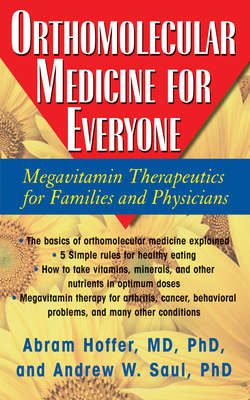Читать книгу Orthomolecular Medicine for Everyone - Abram Hoffer M.D. Ph.D. - Страница 40
На сайте Литреса книга снята с продажи.
SUBCLINICAL VITAMIN DEFICIENCY SYNDROMES
ОглавлениеThe classical deficiency syndromes are rare in technologically advanced nations, but these syndromes—scurvy, pellagra, etc.—were so striking and so devastating that they still remain the main theme of professors of biochemistry who teach medical students. Because they are so infrequently seen, most physicians would fail to recognize them. These deficiency states arise from monotonous diets with very few varieties of food, such as the corn diet that causes pellagra, or from starvation. One deficiency may be predominant but many more are present. The only examples of pure deficiency states may be those produced in experiments on humans and animals and in individuals who are vitamin dependent. Thus, a person who is vitamin B3 dependent on a good diet may have ample quantities of every nutrient except vitamin B3 because he or she requires so much. Some acute schizophrenics may have such a pure deficiency (dependency) state, but the mental changes are much more prominent and the obvious physical changes of pellagra are missing.
Marginal vitamin deficiency is a middle ground between health and frank deficiency. As there are no specific symptoms, this in-between state is not apparent. Vitamin deficiency comes on slowly. During a preliminary stage, body stores of vitamins and minerals are slowly depleted. The second stage, the biochemical stage, occurs when these micronutrients are depleted. Enzymes whose activity depends on having adequate amounts of vitamins work less efficiently, but the individual still appears well in growth and appearance. The third stage is the physiological stage—now enzyme activity is sufficiently impaired to cause personality and behavioral changes. These are nonspecific, including anorexia, depression, irritability, anxiety, insomnia, and somnolence. The final stage is the classical deficiency, a stage near death; the clinical and anatomical changes are now clear. The first three stages comprise the gray area—marginal deficiency or subclinical area, the first term used seventy years ago.
Inadequate intakes of specific nutrients may produce more than one disease. While amyotrophic lateral sclerosis (ALS), progressive muscular atrophy, progressive bulbar palsy, and primary lateral sclerosis are not all the same illness, they and the other neuromuscular diseases may have a common basis: unacknowledged, untreated, long-term vitamin dependency. Therefore, each may respond to an orthomolecular approach such as that successfully used by Dr. Frederick R. Klenner for multiple sclerosis and myasthenia gravis, half a century ago.12
Subclinical vitamin deficiencies produce a variety of symptoms and signs that can mimic an amazing variety of medical and psychiatric syndromes, which may be due to other diseases, such as infections, immune deficiencies, etc. Physicians confronted with these syndromes consider them to be manifestations of these diseases. When they do not respond to treatment, they tend to give them up as psychiatric. Many physicians do not think of any possible connection to nutritional problems. A proper examination of patients’ diets would provide the essential diagnostic clues. When these patients do recover on vitamins they have selected on their own or which have been recommended by others, the recovery is ascribed to faith, to a placebo reaction, or to a natural remission. Nutritional therapy has the remarkable effect of suddenly enhancing the “placebo effect.”
Nutritional deficiencies affect all cells and all organs of the body. With the cells operating at subnormal levels, the whole body must be suffering. Systemic or general symptoms include fatigue, inertia, tension, generalized pain, and muscle irritability. In addition, organs operating at subnormal efficiency will add symptoms and signs unique to that organ. In thinking of the causes of discomfort, physicians should remember that in the absence of readily recognized diseases (such as hyperthyroidism), infection, the presence of fatigue, anxiety, and depression should suggest a thorough search for nutritional factors, especially when the major symptoms develop after severe and prolonged stress. Such stress is common before, during, and after surgery if patients stay very long in a hospital. This is more common following gastrointestinal complications, severe loss of weight, chronic infection, cancer, and other debilitating diseases.
